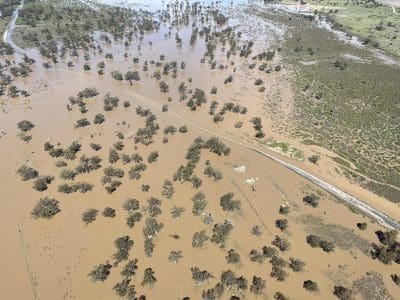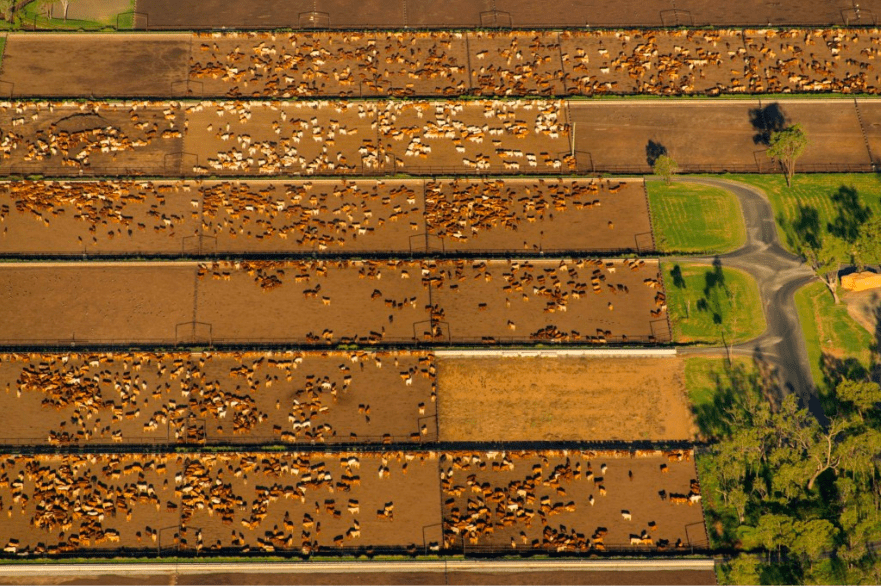
Large grain growing areas, like Moree, have seen major flooding in recent weeks. Photo: Adam Marshall MP
THERE’S a real risk that commercial feedlots in areas of NSW hard-hit by the current rain and flooding event could run out of feedgrain in the next ten days, Beef Central has been told.
The problem appears to extend from as far north as Moree, all the way to feedlots close to the Victorian border and beyond.
Flooding, road closures and other logistical challenges are playing havoc with feeding operations.
A large NSW feedlot operator said the primary problem revolved around getting pre-bought grain out of the depots and silos where it is stored in north and western NSW.
“A lot of those sites are now under water, making it impossible to get grain out, even if some roads are open,” he said.
Some yards he was familiar with were down to two weeks or less in grain reserves – an incredibly tight situation, given that commercial yards typically like to have at least two to three months’ worth of grain supply on hand.
The problem had only been intensified, because many feedlots had earlier run-down their reserves of bought grain, in anticipation of access to cheaper new-season winter cereals due for harvest in coming weeks.
“The second issue is the lack of ability for feedlots to now book-up new season grain, which was due to come in, in four or five weeks’ time,” the lotfeeder said.
“Given the extraordinary conditions that we’ve seen this month, very few people now are committing to selling new-season crop – because they are unsure of the quality and the quantity they are going to have, given the effect on their crops from floodwater and constant rain.”
“Nobody really knows yet what available new season grain supply will be, and how much old-season grain in storage has been damaged by floodwater. It’s left lotfeeders desperately short, and could create a serious bottleneck going forward. It’s also pushed prices sharply higher,” he said.
Price discovery for grain at the moment was described as ‘really difficult’, with very few sellers in the market, despite plenty of lotfeeders desperately trying to secure supply.

Generally speaking, new season grain straight off the header is cheaper than old season grain, but at the moment, it is seen as ‘virtually impossible’ to get a handle on what new season price will be in NSW.
The last winter crop season was always going to be late to harvest, because the seasonal conditions have been so cool. Traditionally much of the harvest in Central NSW is around November, but local opinion now suggests that could be well into December and even January next year. As an example, the hottest day seen in one NSW growing district this spring has been only 25 degrees C.
A lot of paddocks are still knee-deep in water, suggesting it is going to be some time before quality downgrades and tonnage is evaluated. But if this wet spring continues, it could be very difficult to get headers into the paddock at all.
“It’s certainly a twist that the industry did not need at the moment, on top of everything else,” another NSW lotfeeder said.
Some NSW yards that are facing a complete run-out of grain in coming weeks are working on desperate contingency plans, including the use of alternative feedstuffs to maintain energy levels such as recycled bread, biscuit meal, mill-run and other by-products.
“Most local feedlots are very, very low on grain supply,” one NSW industry source said this morning. “Some face the very real risk of running out of grain, with some major local arterial roads still closed or impassable.”
While downgraded wheat and barley due to weather is inevitably cheaper, its nutrient value also dramatically declines. The ability to efficiently process grain with lower test weight reduces, offsetting any price advantage.
“Going from Feed 1 barley to Feed 2 or 3 has a direct correlation to lower performance in the feedlot,” one contact said.
“It’s as difficult a set of circumstances as lotfeeders have faced in this state for a very long time,” he said.
Many yards would now be looking at what summer crop will be grown this summer, give the deep soil moisture profile now in the ground.
“What sort of availability of corn and sorghum will there be?” the contact said. “But it’s a long time before that summer crop comes off – and especially with near record numbers of cattle on feed, the local demand for feedstuffs is really high.”
Cottonseed supply also impacted
“And throw into that mix, the fact that the window to sow cotton in NSW is now only the next two weeks. If cotton is not grown, it slashes access to cotton seed for lotfeeders next year.
“Many lotfeeders already have 2023 cotton seed contracted, and there could well be a number of cotton growers trying to wash-out contracts because of their inability to sow cotton in the planting window.”
“So this feedstuffs shortage issue caused by this year’s spring rain and flooding could echo on for lotfeeders, well into next year.”
Despite margins in feeding cattle being very poor at present, most large yards in eastern Australia remain reasonably close to capacity, with only smaller opportunity yards running number down.
The current rapidly-changing feedgrain situation could seriously test some long established grainfed branded beef supply chains in coming months, one stakeholder believes. More on that in a separate article to come.
A leading feedlot nutritionist told Beef Central this morning that the run-down in stocks old-season grain in anticipation of cheaper prices for new-season cereals had only ‘thrown fuel on the fire’ in the current grain supply crisis.
“The other issue is that cattle in pens where grain runs out may run the risk of not qualifying for National Feedlot Accreditation ‘Grainfed’ status, based on energy requirement,” he said.
“There is a clause in the NFAS guidelines over temporary lapses in diet, but that is related more to heat load events than natural events like floods,” he said.
“The key point is that grain has to be the highest proportion of the ration, and remain above 10Mj of energy. Even though waste bread is grain-derived, it is not counted as grain.”
“This weather event is going to create some huge challenges and disruptions, and will put pressure on grain prices. There’s a big differential between export quality cereals and feed quality.”
“Once that weather-damaged crop eventually starts to get harvested, its likely the price will drop right off, because there will be heaps of it about,” he suggested.
“Some people may simply abandon badly-damaged crops.”
